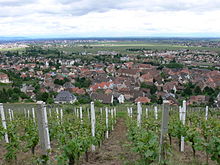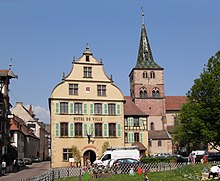Turckheim
| Turckheim | ||
|---|---|---|

|
|
|
| region | Grand Est | |
| Department | Haut-Rhin | |
| Arrondissement | Colmar-Ribeauvillé | |
| Canton | Wintzenheim | |
| Community association | Colmar agglomeration | |
| Coordinates | 48 ° 5 ' N , 7 ° 17' E | |
| height | 219-840 m | |
| surface | 16.46 km 2 | |
| Residents | 3,776 (January 1, 2017) | |
| Population density | 229 inhabitants / km 2 | |
| Post Code | 68230 | |
| INSEE code | 68338 | |
| Website | http://www.turckheim.fr/ | |
 City center |
||
Turckheim (German: Türkheim ) is a French commune with 3776 inhabitants (as of January 1, 2017) in the Haut-Rhin department in the Grand Est region (until 2015 Alsace ). The former imperial city belongs to the arrondissement of Colmar-Ribeauvillé and the canton of Wintzenheim .
geography
The city center is located six kilometers west of Colmar at 232 m above sea level on the Fecht . The Fechttal, which is also called Münstertal (after the city of Munster ), enters the Upper Rhine Plain from the Vosges . The municipality is part of the Ballons des Vosges Regional Nature Park .
The western half of the municipality is determined by the densely forested heights of the Vosges, which reach a maximum height of 840 m above sea level. Part of the high-lying hamlet of Trois-Épis in the north-west also belongs to Turckheim . The former place of pilgrimage is now a center for medical care, spa and aftercare facilities.
Neighboring communities of Turckheim are Niedermorschwihr and Ammerschwihr in the north, Ingersheim in the northeast, Wintzenheim in the east and south, Zimmerbach and Walbach in the southwest and Labaroche in the northwest,
history
Based on Roman finds, it is assumed that the Turckheim area was already settled in Roman times. When Germanic tribes invaded the Roman Empire across the Rhine, the Thuringian tribe settled here, which may have given the place its name Thorencohaime or Thuringheim . In the early Middle Ages , Thuringheim belonged partly to the Münster Abbey and partly to the Hohlandsberg rule. In 1312 Turckheim became a free imperial city , received market and city rights in 1354 and in the same year joined the Alsatian League of Ten Cities , the Decapolis. The three gate towers and the fortifications date from this time. In the Peace of Westphalia , the French crown was awarded the Habsburg possessions in Alsace and subsequently tried to rule over the cities of the Decapolis. In 1675 the armies of the emperor and the great elector were defeated by Turenne in the battle of Türkheim at the gates of the town, which then had to finally evacuate Alsace. The city was sacked. These events were particularly directed towards the nearby, more important Colmar .
From 1871 to 1918 and from 1940 to 1944 the city - like the rest of Alsace - again belonged to the German Empire ( Reichsland Alsace-Lorraine or Gau Baden-Alsace). Between 1899 and 1937 a small electric train ran to the pilgrimage site of Trois Épis ( Three Ears ).
Population development
| year | 1962 | 1968 | 1975 | 1982 | 1990 | 1999 | 2007 | 2017 |
|---|---|---|---|---|---|---|---|---|
| Residents | 3028 | 3028 | 3609 | 3510 | 3567 | 3594 | 3731 | 3776 |
Monuments and landmarks
Three square towers, the Porte du Brand, the Porte de Munster and the Porte de France facing the Rhine plain, along with the remains of the city wall, are evidence of the city fortifications from the 14th century. As in Obernai , the church from the 12th century in Turckheim was demolished. Only the tower of the Church of St. Anna remained next to the town hall ( Hôtel de ville ). On Turckheim's former market square , Place Turenne, there are old houses, the Bürgerstube ( Corps de Garde ), in front of which there is a well worth seeing fountain with a statue of Mary. One of the most impressive half-timbered houses in Turckheim is the "Gasthaus zu den Zwei Schlüsseln" ( Hôtel des deux-clefs ), which has a bay window decorated with carved figures and beautiful stub-paned windows that rests on a stone column. Between May and October a night watchman ( le veilleur de nuit ) with a halberd , lantern, horn and singing parades through the streets at 10 p.m. A small museum with uniform parts, handguns and other exhibits provides information about the fighting at the end of the Second World War for the “Poche de Colmar”.
Economy and Infrastructure
Turckheim's economic basis is based on one of the few Alsatian wines that have become known for their location: the Türkheimer Brand . After the textile and paper industry used to play an important role, today tourism is the main line of business in Turckheim. In addition, many residents commute to the commercial areas of the Colmar agglomeration.
The community has had a train station on the Colmar – Metzeral railway line since 1868 .
Personalities
- Charles Grad (1842–1890), politician
- Victor Sieg (1837–1899), organist and composer
literature
- Le Patrimoine des Communes du Haut-Rhin. Flohic Editions, Volume 2, Paris 1998, ISBN 2-84234-036-1 , pp. 1328-1337.
Web links
- City website (French)
- History and tourism website (German)




